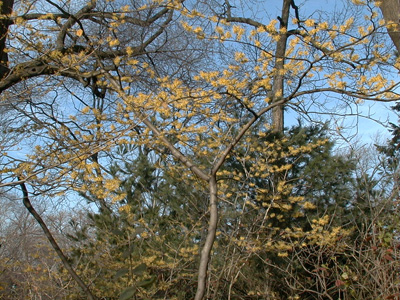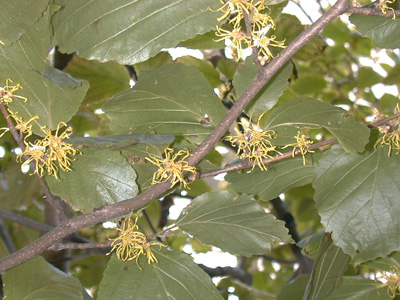
Gardener difficulty rating for genus: 2
yellow-thumb special - easy to grow in right condition

Habitat: witch hazel is native to woodlands east of the Mississippi River.
Hardiness: Its range extends from Zone 4 to 9.
Light: Full sun to shade. Growth will be more compact and vigorous, and flowers will be more profuse in the sun.
Soil and pH: Rich, well drained soil is preferred but they can withstand heavy clay. Average garden pH will do fine. In the wild they are often found on acidic soils and can develop chlorosis (premature yellowing of the leaf blade) if the pH is too alkaline. Lowering the pH with iron sulfate will help prevent chlorosis.
Moisture: Once established, witch hazels are surprisingly drought tolerant. Their presence on the sandy soils of Indiana Dunes National Lakeshore has encouraged me to use witch hazels on berms and slopes without worry. If severely dry, supplemental watering will help.
Planting: Witch hazels are normally sold as balled-and-burlaped shrubs, although you can buy container grown shrubs. They are usually grown in clay and the wood is dense, so even a small plant can be heavy. Use caution with the root ball. Most of the fibrous roots are excluded and the ball will quickly crumble if handled roughly.
 |
The leaves of this variety cover the blooming flowers |
Fall is the best time to buy and plant witch hazel. You can select for bright fall foliage, strong fragrance, and profuse flowering. Some varieties hold their leaves all Winter, which obscures the flowers. Choose varieties that drop their leaves before the main display of flowers.
Pruning/Pinching: Witch hazels rarely require pruning. I prune for shape when I select cutflowers for the house. The rule to remember with witch hazels is flowers bloom on 2 year old wood. New growth from 2005 will not bloom until 2007. Never prune the entire shrub (even for cutflowers) unless you are willing to wait two years for the next bloom.
Pests and Diseases: Witch hazels are rarely affected by pests or diseases. Perhaps the aromatic compounds in witch hazel protect it. However, the hungry, overpopulated rabbits at my community garden ate the young shoots and the some of my witch hazel’s bark last Winter. Although she healed well and grew happily, this Winter I am going to protect the bark with chicken wire.
In the wild I have seen galls on the tips of branches and in the seed capsules, but I have not experienced insect pests in a garden setting.
Propagation: Propagation is possible through soft wood stem cuttings or seeding. Soft wood cuttings in late Spring will root in a moist vermiculite/sand mix. Commercially, many cuttings are grafted to a rootstock to hasten development.
Seeds have uneven germination. In nature they may require two years to break dormancy. If possible, collect the seed in the Summer before the seed coat becomes impermeable. Immediately, sow seed in a constantly moist seed bed amended with organic matter.